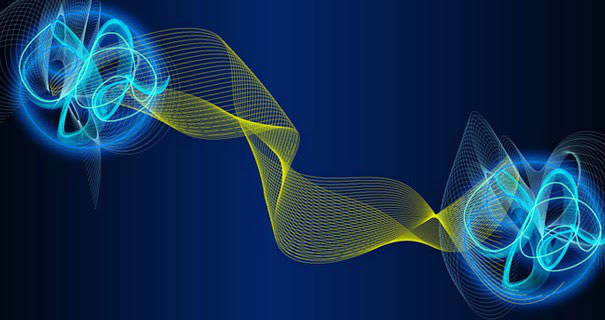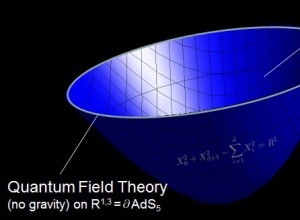All high mathematics serves to do is to beget higher mathematics. ~ Ashim Shanker!
Mathematics is not a careful march down a well-cleared highway, but a journey into a strange wilderness, where the explorers often get lost. Rigour should be a signal to the historian that the maps have been made, and the real explorers have gone elsewhere. W. S. Anglin, in Mathematics and History
In my last post I showed via AdS/CFT analysis, that gravity is an emergent holographic notion: namely, that one can holographically derive (logically deduce) gravity from conformal field theoretic entropic properties of quantum entanglement, and that such a property is a necessary condition for the ‘bundle’ existence of the gravitonic field. To do so, I had to deform CFT by source-fields via the addition of ![]() , which is a dual AdS theory with a bundle field
, which is a dual AdS theory with a bundle field ![]() and a boundary condition
and a boundary condition
![]()
with ![]() the conformal dimension, a local operator
the conformal dimension, a local operator ![]() and
and ![]() equals the number of indices of
equals the number of indices of ![]() substracting the contravariant ones to get the AdS/CFT quasi-isomorphic Maldacena correspondence ( = AdS/CFT correspondence), thus the identity
substracting the contravariant ones to get the AdS/CFT quasi-isomorphic Maldacena correspondence ( = AdS/CFT correspondence), thus the identity
![Rendered by QuickLaTeX.com \[\begin{array}{c}{\left\langle {\Im \{ \exp (\int {{d^4}x{J_{4D}}(X)\vartheta (x))\} } } \right\rangle _{CFT}} = \\{Z_{AdS}}\left[ {\frac{{\lim }}{{boundary}}J{\omega ^{\Delta - d + k}} = {J_{4D}}} \right]\end{array}\]](https://www.georgeshiber.com/wp-content/ql-cache/quicklatex.com-37a60d6a79567a43197d72194a223357_l3.png)
with the left-hand side being the vacuum expectation value of the time-ordered exponential of the operator over CFT, the right-hand side being the quantum gravity functional with topological-conformal boundary condition, thus leading to holographic emergence, and in a sense, elimination, of gravity. Recall that the Heisenberg Uncertainty Relation holds for energy and time, leading to many anomalies for the Green‘s function of string-propagation:
![Rendered by QuickLaTeX.com \[G({X_{{\sigma _t}(a)}},{X_{{\sigma _t}(b)}}) = \int {{}^sD\exp \left( { - \int_{{\sigma _t}(b)}^{{\sigma _t}(a)} {d{\sigma _t}\int_0^\pi {d{\sigma _t}} } } \right)} \,L\]](https://www.georgeshiber.com/wp-content/ql-cache/quicklatex.com-eede9d9b6212669db1ed3d34d8114ee9_l3.png)
with ![]() the Lagragian, due to the fact the
the Lagragian, due to the fact the ![]() superpositionality with respect to energy makes Feynman path-summation:
superpositionality with respect to energy makes Feynman path-summation:
![]()
incoherent since some topologies will degenerate and violate existence conditions for tangent bundles over Minkowski spacetime and some will not correspond to the categorical CFT-manifold, and hence we need to replace the Green’s function with the Källén–Lehmann spectral representation. This is where the GKP-Witten Relation enters with all its glory:
![]()
with background deficit angle ![]() and the curvature localized on the boundary with an angular deficit:
and the curvature localized on the boundary with an angular deficit:
![]()
with action
![Rendered by QuickLaTeX.com \[\begin{array}{c}{S_A} = \frac{1}{{16\pi {G_N}}}\int {d{x^{d + 2}}} \sqrt g R + \to \\{\rm{Area}}\frac{{({\gamma _A})}}{{4{G_N}}} \cdot (n - 1)\end{array}\]](https://www.georgeshiber.com/wp-content/ql-cache/quicklatex.com-42288341570bc8ef38387d42f8ff563e_l3.png)
giving us
![Rendered by QuickLaTeX.com \[\begin{array}{*{20}{c}}{{S_A} = \frac{\partial }{{{\partial _n}}}{\rm{log}}{\mkern 1mu} {\rm{T}}{{\rm{r}}_A}{\mkern 1mu} {\rho ^n} = - \frac{\partial }{{{\partial _n}}}{\rm{log}}\left( {\frac{{{Z_n}}}{{{{\left( {{Z_1}} \right)}^n}}}} \right)}\\\begin{array}{c} = {\rm{Area}}\frac{{\left( {{\gamma _A}} \right)}}{{4{G_N}}} \cdot \\\delta {S_{GRAVITY}} = 0 \to {\gamma _A} = {\rm{ minimal surface!}}\end{array}\end{array}\]](https://www.georgeshiber.com/wp-content/ql-cache/quicklatex.com-1d9aa587ca824a160f60615555b8b32a_l3.png)
with
![]()
hence solving the ‘Ricci/dilaton’ problem I discussed in my last post, since now the holographic formula is
![]()
with the ‘magical’ expression (![]() being the string lenght):
being the string lenght):
![]()
and with that, the GKP-Witten relation solves the ‘Ricci/dilaton’ problem for the action of supergravity theory.
Now let me set up the mathematical context needed to show, in a forthcoming post, that even in M-Theory, or for that matter: any quantum-gravity theory, one cannot coherently quantize gravity in a way that satisfies General Relativistic ‘necessity-criteria’ – as I will show that this would imply, via gravitonic quantum entanglement, the point-‘instantaneous’ collapse of spacetime to a zero-dimensional point like singularity. Not a pretty picture! To do that I have to show that boundary AdS/CFT admits of a ‘local’ symmetry in the bulk theory that is dual to a ‘global’ symmetry corresponding to the boundary and that the (Gubser-Klebanov-Polyakov)-Witten relation deduces the Green correlation functions and that they must have negative Källén–Lehmann spectral representation
![]()
with ![]() being the gauge-theoretic positive-definite spectral density function.
being the gauge-theoretic positive-definite spectral density function.
In the AdS/CFT duality, one must note that the second derivative of the on-shell action principle with respect to the bulk ![]() second-quantized field, must, by unitarity, be identical to the Green function of the
second-quantized field, must, by unitarity, be identical to the Green function of the ![]() current
current
![Rendered by QuickLaTeX.com \[\begin{array}{c}1.\quad {\left. {\frac{{{\delta ^2}{S_{CFT}}}}{{\delta {A_\mu }(x)\delta A\nu (x')}}} \right|_{u = 0}}\\ \to {G^{\mu \nu }}(x - x') = - {\left\langle {{T_E}{J^\mu }(x){J^\nu }(x')} \right\rangle _G}\end{array}\]](https://www.georgeshiber.com/wp-content/ql-cache/quicklatex.com-a20856c163bcf93b6e1ff3aa76e7ae1e_l3.png)
with ![]() being the Euclidean time-ordering, and
being the Euclidean time-ordering, and ![]() the Green function.
the Green function.
For equation 1. to be true, the connected Green function ![]() should provably reduce to the static response function
should provably reduce to the static response function ![]() in the stationary limit of the following ‘identity’ 2.
in the stationary limit of the following ‘identity’ 2.
![Rendered by QuickLaTeX.com \[2.\quad \mathop {{K^{ij}}}\limits^\_ (k) \equiv {(2\pi )^{p + 1}}{\left. {\frac{{{\delta ^2}_{CFT}}}{{\delta A_i^\dagger ( - k)\delta A_i^\dagger (k)}}} \right|_{u = 0}}\]](https://www.georgeshiber.com/wp-content/ql-cache/quicklatex.com-62286c0e9d56f59f6b0f6eb0f6ba6fe4_l3.png)
thus, from the limit, one gets the conjectural equation
![]()
But this cannot be true since the holographic Källén–Lehmann spectral representation implies that
![]()
whereas ![]()
Now, the definite-negativeness of ![]() can be derived from the Källén–Lehmann spectral representation of the ‘connected’ Green function:
can be derived from the Källén–Lehmann spectral representation of the ‘connected’ Green function:
![]()
where ![]() must be the Matsubara frequencies and
must be the Matsubara frequencies and ![]() is a Fourier spectral functional transform of:
is a Fourier spectral functional transform of:
![]()
However, this spectral function satisfies
![]()
thus leading to the definite-negativeness of:
![Rendered by QuickLaTeX.com \[6.\quad \mathop {{G^{ii}}}\limits^ - (o,k) = - \int_{ - \infty }^\infty {\frac{{d\omega }}{{2\pi }}} \frac{{\mathop {{\rho ^{ii}}(\omega ,k)}\limits^ - }}{\omega } < 0\]](https://www.georgeshiber.com/wp-content/ql-cache/quicklatex.com-d6afcfce8c73271c354d5e8b20beb61a_l3.png)
no ‘summing’ over ‘i’. Because the ‘connected’ Green function and the holographic Källén–Lehmann spectral representational functional differ by a sign,
![]()
must be false!
A resolution to this contradiction is obtained by noting that the AdS/CFT bulk theory has gauge symmetry and the boundary theory has background-local ![]() symmetry: hence the
symmetry: hence the ![]() current
current ![]() does contain an external source field
does contain an external source field ![]() . In such a case, the Källén–Lehmann spectral representational functional can differ from the Green function, and the GKP-Witten relation yields the holographic Källén–Lehmann spectral function instead of the Green function. To show how this works, take a complex scalar field
. In such a case, the Källén–Lehmann spectral representational functional can differ from the Green function, and the GKP-Witten relation yields the holographic Källén–Lehmann spectral function instead of the Green function. To show how this works, take a complex scalar field ![]() coupled to the the electromagnetic field
coupled to the the electromagnetic field ![]() :
:
![Rendered by QuickLaTeX.com \[\begin{array}{c}{S_A}\left[ \phi \right] = \int {{d^{p + 1}}} x \cdot \\\left( {{{\left| {\left( {{{\not \partial }_\mu } - ie{A_\mu }} \right)} \right|}^2} + V\left( {\left| \phi \right|} \right)} \right)\end{array}\]](https://www.georgeshiber.com/wp-content/ql-cache/quicklatex.com-8ea0a623ec6705cc28addbe204ad5f03_l3.png)
Now, the current
![]()
contains the electromagnetic field ![]() by the background local
by the background local ![]() symmetry. Now, one can generate the functional
symmetry. Now, one can generate the functional
![]()
thus deriving the current expectation value as
![]()
with a ‘response’ functional
![]()
given by
![Rendered by QuickLaTeX.com \[\begin{array}{c}10.\quad {K^{\mu \nu }}(x): = - \frac{{\delta \left\langle {{J^\mu }(x)} \right\rangle }}{{\delta {A_\nu }(0)}} = - \frac{{{\delta ^2}W{\rm{[}}A{\rm{]}}}}{{\delta {A_\nu }(0)\delta {A_\mu }(x)}}\\ = {G^{\mu \nu }}(x) - \left\langle {\frac{{\delta {J^\mu }(x)}}{{\delta {A_\nu }(0)}}} \right\rangle \\ = {G^{\mu \nu }}(x) + 2{e^2}{\delta ^{\mu \nu }}\delta (x)\left\langle {{{\left| {\phi (x)} \right|}^2}} \right\rangle \end{array}\]](https://www.georgeshiber.com/wp-content/ql-cache/quicklatex.com-06dc3031a5cf367eb782af9e87859a14_l3.png)
where ![]() is the ‘connected’ Green function for the current
is the ‘connected’ Green function for the current ![]()
![]()
Therefore, the Källén–Lehmann spectral representation functional differs from the ‘connected’ Green function by the second term of
![]()
Hence, the ‘negativity’ is not reflected in the Källén–Lehmann spectral representation functional and from
![]()
one gets the GKP-Witten relational implication:
![]()
Applied in a forthcoming post to the quantum gravitational field
![]()
I will derive, via quantum entanglement and gravitonic vacuua analysis, the collapse of spacetime to a zero-dimensional point-like singularity that also violates the Theory of Special Relativity (in fact, what will it not violate), and the GKP-Witten Relation will be central in that analysis. Note: the AdS/CFT holography principle entropically implies the ’emergence’-property, and thus quantum-field-theoretic elimination, of the gravitational field.



